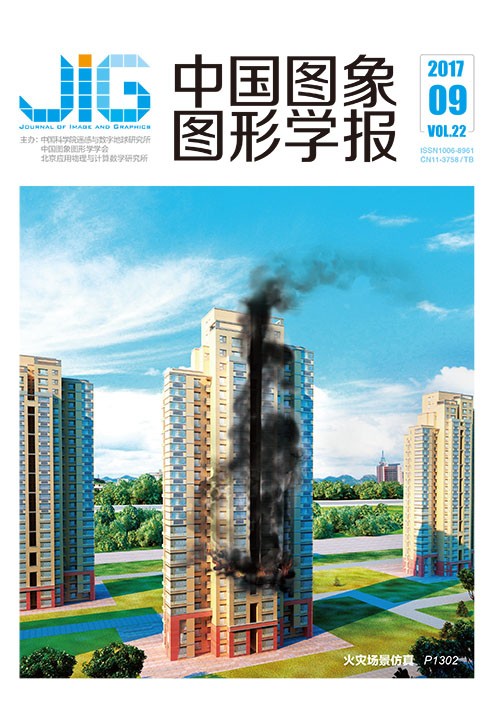
二轴转台测角法用于线阵相机几何参数标定
摘 要
目的 目前对线阵相机的几何参数标定方法比较少,而且已有标定方法都需要特殊、高精度要求的设备,为此提出一种基于二轴转台测角法的线阵相机标定方法,通过简单的设备高精度求取线阵相机的内参数和畸变参数。方法 通过简化面阵相机成像模型,建立线阵相机成像模型且推导出参数计算公式,提出测角法标定流程并设计了专门的标定板,利用图像边缘检测得到标定板黑白条纹的边缘点坐标,结合二轴转台的角度信息,代入成像模型中,主要采用最小二乘法和迭代优化算法,求取线阵相机的内参和畸变参数。同时指出了该方法的适用性和标定精度依赖于转台精度、镜头视场角和感光器件分辨率。结果 对3只不同焦距的镜头进行标定实验,分析了内参数和畸变参数迭代优化过程,焦距的标定精度优于5 μm、主点的标定精度优于3 μm,与其他文献中高成本方法进行相比,处于同一数量级。结论 提出一种新的线阵相机几何参数标定方法,该方法利用低成本二轴转台和黑白条纹标定板即可高精度标定出线阵相机几何参数。该方法的适用性依赖转台精度、镜头视场角和感光器件分辨率,对于步长为0.012 9°的转台和分辨率为1 436的线阵相机,最多只能标定焦距为16 mm的镜头,而焦距更长的镜头需要更高精度的转台。
关键词
Calibration of a linear camera based on a two-axis pan-tilt mechanism via angle measurement
Zhou Zicong1, Lyu Wu2, Liu Yang1, Xu Ze'en1, Ma Jie1(1.Nation Key Laboratory of Science and Technology on Multi-Spectral Information Processing, Huazhong University of Science and Technology, Wuhan 430074, China;2.System Engineering Research Institute of China State Shipbuilding Corporation, Beijing 100036, China) Abstract
Objective The methods for calibrating a linear camera are limited,and most of them require special and high-accuracy equipment.The calibration of a linear camera is performed to obtain focus length,principal point,and distortion parameters.A linear model cannot be solved without additional constraints because the imaging model for a linear camera differs from that for a planar camera.This study proposed a new method for calibrating a linear camera based on a two-axis pan-tilt mechanism using angle measurement and a black-and-white striped board.We reduced the number of internal,external,and distortion parameters,and then made the model solvable by simplifying the planar camera model and providing considerable constraint information.We mainly used the least squares method and iterative optimization to obtain stable results.Results showed that the accuracy of this study could reach the same micron level of other research that used expensive equipment.Method The most popular method for planar camera calibration is the method of Zhang,which uses a chess board to gain world and image coordinate points and the congruent relationship among these points to calculate homography matrix.The internal parameters can be determined from the homography matrix via singular value decomposition,and the distortion parameters are obtained using Brown's method.However,a linear camera model differs from a planar camera model.Therefore,the method of Zhang cannot be used to calibrate a linear camera,and constraints are insufficient to solve the model.We established a linear camera model by limiting the dimensions of a planar camera model to only one based on the planar camera model and method of Zhang.Only two internal parameters should be solved,namely,focus length and principal point.However,many external parameters were required to be calculated,but the constraints were inadequate,thereby causing the model to become unsolvable.We designed a calibration board to create additional constraints to reduce the unknown external parameters.We then proposed a procedure for calibrating a linear camera,which adjusted the pose of the two-axis pan-tilt mechanism and the black-and-white striped board.Finally,the external parameters could be reduced to only two.However,the linear camera model remained unsolvable.We used a two-axis pan-tilt mechanism to obtain angle information to solve the problem.We calculated the internal and external parameters of the linear camera by using the edge points of the black-and-white striped board obtained via edge detection,the angles measured using the two-axis pan-tilt mechanism,the geometric model,and the least squares method.We acquired the initial value of the internal parameters and integrated them into the distortion formula,which was simplified from the distortion model for the planar camera model,to determine the initial value of the distortion parameters.Subsequently,iterative optimization was performed to optimize the internal and distortion parameters to gain stable results.The applicability and precision of this calibration method depend on three factors:the precision of the two-axis pan-tilt mechanism,the lens angle,and the resolution of the CCD camera.Result In the experiment,we repeatedly measured the internal and distortion parameters of three lenses (6 mm,8 mm,and 10 mm) based on the proposed method and analyzed the iterative optimization of the internal and distortion parameters,which could achieved a stable result within four iterations.We then used relative standard deviation (RSD) to calculate calibration accuracy.The RSD of the focus length of the three lenses was less than 0.05%,whereas the RSD of the principal point was less than 0.1%.Therefore,the proposed method is feasible and stable.Focal length calibration accuracy was better than 5 μm,whereas principal calibration accuracy was better than 3 μm.Compared with other studies that used expensive equipment for calibration,we could achieve the same micron level accuracy with a low cost.We simply used a two-axis pan-tilt mechanism and a printed calibration board,and calibration could be performed anywhere using this simple equipment.This approach can save significant money,time,and work.Nevertheless,the applicability of this method depends on the precision of the two-axis pan-tilt mechanism,the lens angle,and the resolution of the CCD camera.If the step size of the two-axis pan-tilt mechanism is 0.012 9° and the resolution of the CCD camera is 1 436,then this calibration method can work the best on a 16 mm lens.For a lens with longer focus length,the precision of the two-axis pan-tilt mechanism should be increased.Conclusion This study proposed a new method for calibrating a linear camera,which established the model for a linear camera,derived the formulas,and provided the calibration process.The feasibility of this method was also analyzed.The linear camera model was built by simplifying the planar camera model.The number of parameters to be solved was reduced to a minimum by adjusting the pose of the two-axis pan-tilt mechanism and the black-and-white striped board.We used angle information from the two-axis pan-tilt mechanism to make the model solvable,and iterative optimization was performed to obtain reliable and stable internal and distortion parameters.Three lenses with different focus lengths were tested based on our method to calculate the internal and distortion parameters.The result showed that the accuracy of this study could reach the same micron level as that of other research that used expensive equipment.We can test only lenses with a focus length that does not exceed 16 mm because of the limit in the precision of the two-axis pan-tilt mechanism and the resolution of the CCD camera.If we intend to calibrate lenses with longer focus lengths,then we will require a two-axis pan-tilt mechanism with higher precision.Further study will be conducted using better equipment to test more lens under different situations.
Keywords
|



 中国图象图形学报 │ 京ICP备05080539号-4 │ 本系统由
中国图象图形学报 │ 京ICP备05080539号-4 │ 本系统由